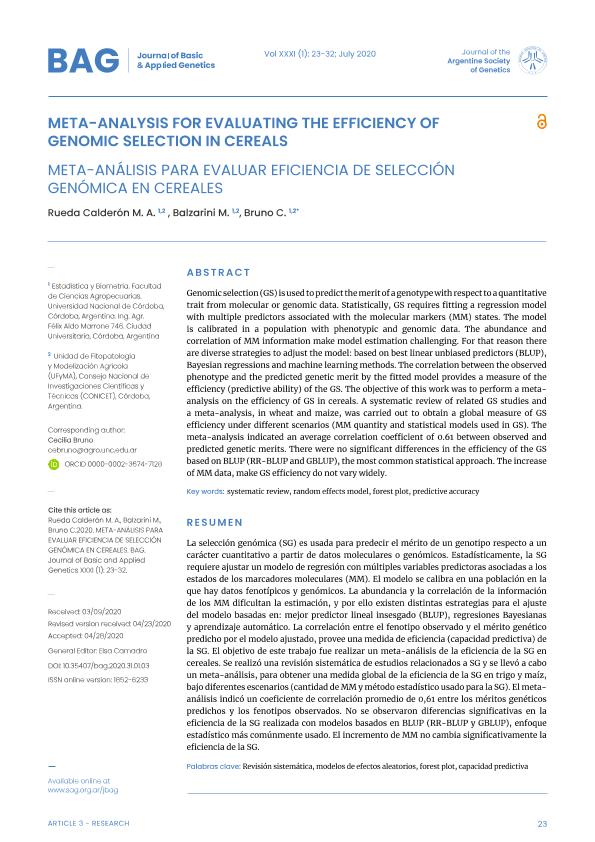Artículo
La selección genómica (SG) es usada para predecir el mérito de un genotipo respecto a un carácter cuantitativo a partir de datos moleculares o genómicos. Estadísticamente, la SG requiere ajustar un modelo de regresión con múltiples variables predictoras asociadas a los estados de los marcadores moleculares (MM). El modelo se calibra en una población en la que hay datos fenotípicos y genómicos. La abundancia y la correlación de la información de los MM dificultan la estimación, y por ello existen distintas estrategias para el ajuste del modelo basadas en: mejor predictor lineal insesgado (BLUP), regresiones Bayesianas y aprendizaje automático. La correlación entre el fenotipo observado y el mérito genético predicho por el modelo ajustado, provee una medida de eficiencia (capacidad predictiva) de la SG. El objetivo de este trabajo fue realizar un meta-análisis de la eficiencia de la SG en cereales. Se realizó una revisión sistemática de estudios relacionados a SG y se llevó a cabo un meta-análisis, para obtener una medida global de la eficiencia de la SG en trigo y maíz, bajo diferentes escenarios (cantidad de MM y método estadístico usado para la SG). El metaanálisis indicó un coeficiente de correlación promedio de 0,61 entre los méritos genéticos predichos y los fenotipos observados. No se observaron diferencias significativas en la eficiencia de la SG realizada con modelos basados en BLUP (RR-BLUP y GBLUP), enfoque estadístico más comúnmente usado. El incremento de MM no cambia significativamente la eficiencia de la SG. Genomic selection (GS) is used to predict the merit of a genotype with respect to a quantitative trait from molecular or genomic data. Statistically, GS requires fitting a regression model with multiple predictors associated with the molecular markers (MM) states. The model is calibrated in a population with phenotypic and genomic data. The abundance and correlation of MM information make model estimation challenging. For that reason there are diverse strategies to adjust the model: based on best linear unbiased predictors (BLUP), Bayesian regressions and machine learning methods. The correlation between the observed phenotype and the predicted genetic merit by the fitted model, provides a measure of the efficiency (predictive ability) of the GS. The objective of this work was to perform a meta-analysis on the efficiency of GS in cereal. A systematic review of related GS studies and a meta-analysis, in wheat and maize, was carried out to obtain a global measure of GS efficiency under different scenarios (MM quantity and statistical models used in GS). The meta-analysis indicated an average correlation coefficient of 0.61 between observed and predicted genetic merits. There were no significant differences in the efficiency of the GS based on BLUP (RR-BLUP and GBLUP), the most common statistical approach. The increase of MM data make GS efficiency do not vary widely.
Meta-analysis for evaluating the efficiency of genomic selection in cereals
Título:
Meta-análisis para evaluar eficiencia de selección genómica en cereales
Fecha de publicación:
07/2020
Editorial:
Sociedad Argentina de Genética
Revista:
Basic and Applied Genetics
ISSN:
1853-7138
e-ISSN:
1852-6233
Idioma:
Español
Tipo de recurso:
Artículo publicado
Clasificación temática:
Resumen
Archivos asociados
Licencia
Identificadores
Colecciones
Articulos (UFYMA)
Articulos de UNIDAD DE FITOPATOLOGIA Y MODELIZACION AGRICOLA
Articulos de UNIDAD DE FITOPATOLOGIA Y MODELIZACION AGRICOLA
Citación
Rueda Calderón, María Angélica; Balzarini, Monica Graciela; Bruno, Cecilia Ines; Meta-analysis for evaluating the efficiency of genomic selection in cereals; Sociedad Argentina de Genética; Basic and Applied Genetics; XXXI; 1; 7-2020; 23-32
Compartir
Altmétricas




